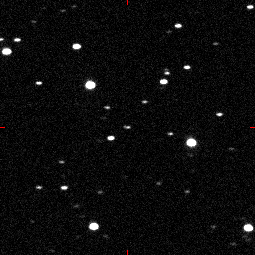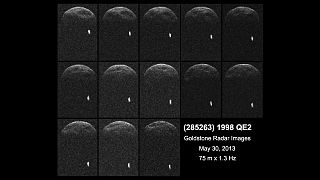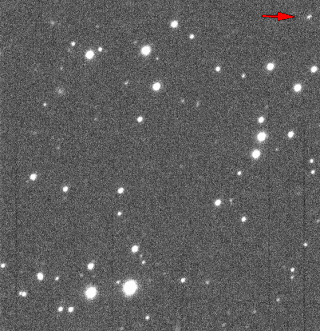Related Research Articles

2004 FH is a micro-asteroid and near-Earth object of the Aten group, approximately 30 meters in diameter, that passed just 43,000 km (27,000 mi) above the Earth's surface on 18 March 2004, at 22:08 UTC. It was the 11th closest approach to Earth recorded as of 21 November 2008. The asteroid was first observed on 16 March 2004, by astronomers of the Lincoln Near-Earth Asteroid Research at the Lincoln Laboratory's Experimental Test Site near Socorro, New Mexico.

1862 Apollo is a stony asteroid, approximately 1.5 kilometers in diameter, classified as a near-Earth object (NEO). It was discovered by German astronomer Karl Reinmuth at Heidelberg Observatory on 24 April 1932, but lost and not recovered until 1973.

66391 Moshup, provisional designation 1999 KW4, is a binary asteroid, classified as a near-Earth object and potentially hazardous asteroid of the Aten group, approximately 1.3 kilometers in diameter. It was discovered on 20 May 1999, by Lincoln Near-Earth Asteroid Research (LINEAR) at the Lincoln Laboratory's Experimental Test Site in Socorro, New Mexico, United States. It is a Mercury-crosser that comes extremely close to the Sun at a perihelion of 0.2 AU.
2059 Baboquivari, provisional designation 1963 UA, is an asteroid classified as near-Earth object of the Amor group, approximately 1.9 kilometers in diameter. Discovered by the Indiana Asteroid Program in 1963, it was later named after the Baboquivari Mountains in Arizona, United States.

(450894) 2008 BT18 is a sub-kilometer asteroid and synchronous binary system, classified as near-Earth object and potentially hazardous asteroid of the Apollo group. It was discovered on 31 January 2008, by the LINEAR program at Lincoln Laboratory's Experimental Test Site near Socorro, New Mexico, United States. The eccentric asteroid measures approximately 600 meters in diameter and has a composition of a basaltic achondrite.
(5646) 1990 TR is a probable rare-type binary asteroid classified as near-Earth object of the Amor group, approximately 2.3 kilometers in diameter. It was discovered on 11 October 1990, by Japanese astronomers Seiji Ueda and Hiroshi Kaneda at Kushiro Observatory near Kushiro, in eastern Hokkaido, Japan.
(6491) 1991 OA is a highly eccentric, stony asteroid, classified as near-Earth object and potentially hazardous asteroid, approximately half a kilometer in diameter. It was discovered on 16 July 1991, by American astronomer Henry E. Holt at the U.S. Palomar Observatory in California.

2010 TD54 is a tiny asteroid and fast rotator, classified as a near-Earth object of the Apollo group, approximately 5 meters in diameter. It was first observed by the Mount Lemmon Survey in October 2010, when the asteroid crossed through the Earth-moon system and had a close encounter with Earth.

(7482) 1994 PC1 is a stony asteroid, classified as near-Earth object and potentially hazardous asteroid of the Apollo group, approximately 1.1 kilometers in diameter. It was discovered on 9 August 1994, by astronomer Robert McNaught at the Siding Spring Observatory in Coonabarabran, Australia. With an observation arc of 47 years it has a very well known orbit and was observed by Goldstone radar in January 1997. The 2022 approach has been observed every month since August 2021.

(285263) 1998 QE2, provisional designation 1998 QE2, is a dark asteroid and synchronous binary system, classified as near-Earth object and potentially hazardous asteroid of the Amor group, approximately 3 kilometers in diameter. It was discovered on 19 August 1998, by astronomers of the LINEAR program at Lincoln Laboratory's Experimental Test Site near Socorro, New Mexico, in the United States. Its sub-kilometer minor-planet moon was discovered by radar on 30 May 2013.

(511002) 2013 MZ5, provisional designation 2013 MZ5, is a sub-kilometer asteroid, classified as a near-Earth object of the Amor group, estimated to measure approximately 300 meters (1,000 feet) in diameter. It was discovered on 18 June 2013, by astronomers with the Pan-STARRS survey at Haleakala Observatory on the island of Maui, Hawaii, in the United States. It was the 10,000th near-Earth object ever discovered.
(31345) 1998 PG is an eccentric, stony asteroid and binary system, classified as near-Earth object of the Amor group of asteroids, approximately 900 meters in diameter. It minor-planet moon, S/2001 (31345) 1, has an estimated diameter of 270 meters.

(88710) 2001 SL9 (provisional designation 2001 SL9) is a sub-kilometer asteroid and binary system, classified as near-Earth object of Apollo group discovered by NEAT at Palomar Observatory on 18 September 2001. It measures approximately 960 meters in diameter, while its 2001-discovered minor-planet moon has an estimated diameter of 200 meters based on a secondary to primary mean-diameter ration of 0.28.

(357439) 2004 BL86 is a bright sub-kilometer asteroid and binary system, classified as near-Earth object and potentially hazardous asteroid of the Apollo group, approximately 300 meters (980 ft) in diameter. It was discovered on 30 January 2004 by astronomers of the Lincoln Near-Earth Asteroid Research at Lincoln Laboratory's Experimental Test Site near Socorro, New Mexico. Its 70-meter (200 ft) moon was discovered during the asteroid's close approach to the Earth in January 2015.
(523775) 2014 YB35, provisional designation 2014 YB35, is a stony near-Earth object and potentially hazardous asteroid of the Apollo group, approximately 300 meters (980 feet) in diameter. It was discovered on 27 December 2014 by the Catalina Sky Survey at the Catalina Station in Arizona, United States. In March 2015, a minor-planet moon, less than half the size of its primary, was discovered by radar astronomers at Goldstone Observatory. The primary body of the binary system has a rotation period of 3.3 hours, while the secondary's orbital period remains unknown.
11885 Summanus is a dark asteroid and large near-Earth object of the Apollo group. It was discovered by astronomers with the Spacewatch programm at Kitt Peak Observatory on 25 September 1990. The object has a rotation period of 7.3 hours and measures approximately 1.3 kilometers in diameter. It was named after Summanus, the Roman deity of nocturnal lightning and thunder.

(190166) 2005 UP156 is a stony asteroid and binary system, classified as near-Earth object of the Apollo group, approximately 1 kilometer in diameter. It was discovered on 31 October 2005, by astronomers of the Spacewatch survey at the Kitt Peak National Observatory in Arizona, United States. Its minor-planet moon with an orbital period of 40.25 hours was discovered in 2017.
2013 GM3 is a micro-asteroid, classified as near-Earth object of the Aten group, approximately 20 meters in diameter. It was first observed on 3 April 2013, by astronomers of the Mount Lemmon Survey conducted at the Mount Lemmon Observatory near Tucson, Arizona, United States.

2018 DV1 is a micro-asteroid, classified as a near-Earth object of the Aten group, approximately 6–12 meters (20–40 feet) in diameter. It was first observed on 26 February 2018, by astronomers of the Mount Lemmon Survey at Mount Lemmon Observatory, Arizona, five days prior to its sub-lunar close encounter with Earth at less than 0.3 lunar distance.

(164121) 2003 YT1, provisional designation 2003 YT1, is a bright asteroid and synchronous binary system on a highly eccentric orbit, classified as near-Earth object and potentially hazardous asteroid of the Apollo group, approximately 2 kilometers (1.2 miles) in diameter. It was discovered on 18 December 2003, by astronomers with the Catalina Sky Survey at the Catalina Station near Tucson, Arizona, in the United States. The V-type asteroid has a short rotation period of 2.3 hours. Its 210-meter sized minor-planet moon was discovered at Arecibo Observatory in May 2004.
References
- 1 2 3 "JPL Small-Body Database Browser: 5381 Sekhmet (1991 JY)" (2015-05-13 last obs.). Jet Propulsion Laboratory . Retrieved 7 January 2016.
- ↑ "Sekhmet". Dictionary.com Unabridged (Online). n.d.
- 1 2 "5381 Sekhmet (1991 JY)". Minor Planet Center. Retrieved 7 January 2016.
- 1 2 3 "LCDB Data for (5381) Sekhmet". Asteroid Lightcurve Database (LCDB). Retrieved 7 January 2016.
- 1 2 Neish, C. D.; et al. (December 2003), "Radar Observations of Binary Asteroid 5381 Sekhmet", Bulletin of the American Astronomical Society, 35: 1421, Bibcode:2003AAS...20313402N